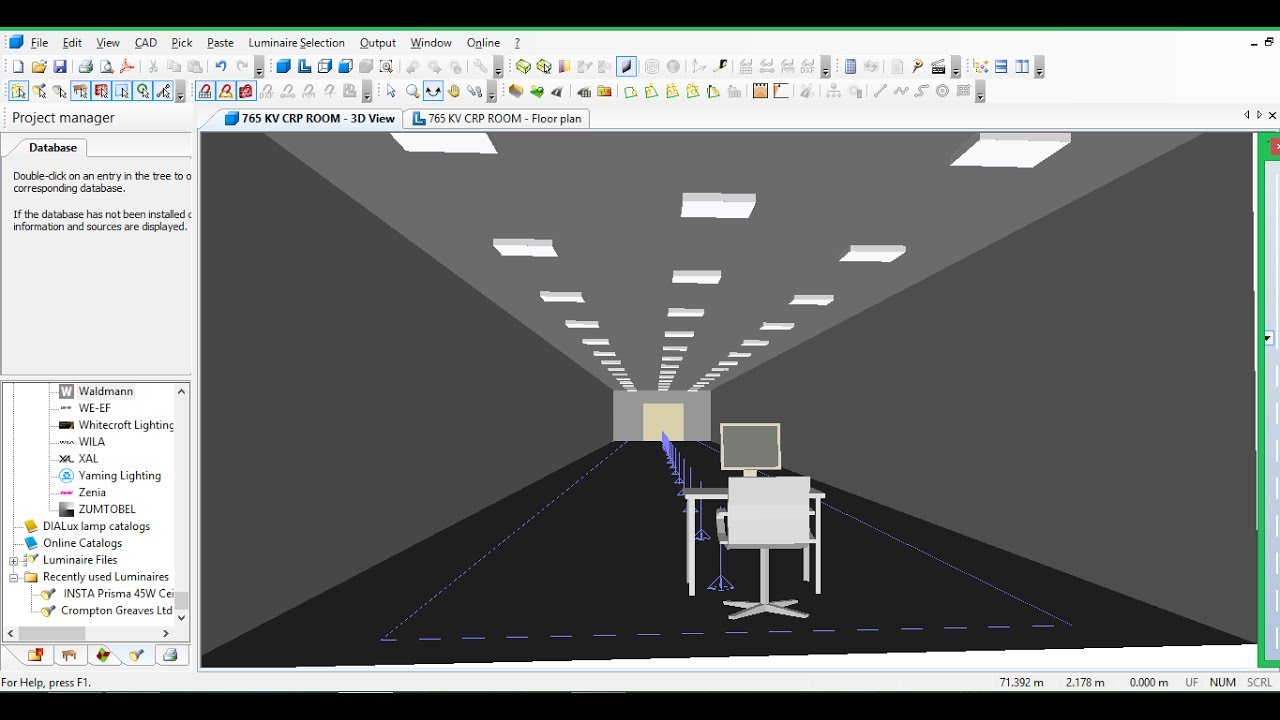Technical Information
ROI Payback Calculator
See how much you can save on your electricity bill by switching to LED lamps. Enter your details in the form below.
| Existing Bulb/Lamp | LED Replacement | |
|---|---|---|
| Wattage (W) | ||
| Number of Lamps | 12 | |
| Electricity Cost per kWh (cent) | 15 | |
| Hours ON per Day (avg) | 8 | |
| Electricity Cost per Day | 0.00 | 0.00 |
| Days used per Year (est) | 300 | |
| Cost per Year | 0.00 | 0.00 |
| SAVINGS € | |
|---|---|
| Saving per Year | 0.00 |
| Saving per Month | 0.00 |
| Percent Saving | 0 |
| LED lamp Cost (each) | |
| Total Investment | 0.00 |
| Payback Period – Years | 0 |
| Payback in Months | 0 |
Dialux
Dialux is an extensive light calculation program for professional light calculations. The Dialux program is an independent program that includes all major lighting manufacturers and their luminaires.
Worldwide, Dialux is the best known and most used light calculation program within the lighting industry. It is an advanced program tailored to the wishes of lighting designers.
Dialux is continuously optimized by a specially dedicated team. Using Dialux, we can convert the lighting requirements of customers into lighting calculations and make plans with access to all luminaires of the better known lighting manufacturers.
Midland Lighting are happy to make a professional light calculation for you using Dialux.

IP Ratings Guide
There are two numbers behind the letters IP. This indicates the degree of protection. The first digit indicates the degree of protection against solids. The second digit indicates the degree of protection against liquids (moisture).
The first digit of the IP value;
- IP 0x = not protected
- IP 1x = protected against objects with a diameter> 50 mm
- IP 2x = protected against objects with a diameter> 12 mm
- IP 3x = protected against objects with a diameter> 2.5 mm
- IP 4x = protected against objects with a diameter> 1 mm
- IP 5x = protected against dust
- IP 6x = dust proof
The second digit of IP value;
- IP x0 = not protected
- IP x1 = protected against dripping water
- IP x2 = protected against dripping water at an inclined position of up to 15 degrees
- IP x3 = protected against spraying water
- IP x4 = protected against splashing water
- IP x5 = protected against water jets
- IP x6 = protected against downpours
- IP x7 = protected against submersion (30 mins to 1m deep)
- IP x8 = protected against submersion (30 mins to 1.5m deep)
- IP x9 = protected against high pressure washing and steam

IK Value
I like ratings
The various IK classifications are laid down in the EN 62262 standard and have 10 different values:
- IK 00 = No resistance
- IK 01 = Resistance to shocks of 0.15 J
- IK 02 = Resistance to shock of 0.2 J (standard open luminaire)
- IK 03 = Shock resistance of 0.35 J (standard luminaire with polymethacrylate shield)
- IK 04 = Resistance to shocks of 0.5 J
- IK 05 = Resistance to impact of 0.7 J (open luminaire with reinforced optics)
- IK 06 = Resistance to shocks of 1 J
- IK 07 = Resistance to shocks of 2 J (reinforced)
- IK 08 = Shock resistance of 5 J (closed luminaire with polycarbonate or glass cover, protected against vandalism)
- IK 09 = Resistance to shocks of 10 J
- IK 10 = Shock resistance of 20 J (vandal-proof closed luminaire)
Vandal resistance
The IK designation is also often used to clarify the degree of vandal resistance of a luminaire.

Color temperature, Kelvin, CRI
CRI values
The color rendering index is indicated with values between 0 and 100 Ra. The value 100 Ra means that the light from the light source is identical to that from the reference light source. Light sources with a CRI of 100 Ra provide the truest color renditions. The lower the CRI is, the less accurately the lighting renders the colors.
Different display colors
A lamp with a warm white light color can have the same CRI as a lamp with a cold white light color. The color temperature (Kelvin) of the lamp therefore has no influence on the CRI. However, the color temperature can cause a different perception of the colors. The color of lighting is indicated by the number of Kelvin (K). The lower the number and therefore the color temperature, the warmer the light. The standard Kelvin values start at 2700K (extra warm white) to 6500K (very cold white).
Color temperature examples
- Sunrise: 2000K
- Halogen lamp: 3000K
- Daylight: 5000K
- Clear blue sky: 6500K

CIBSE Recommended LUX Levels
| Area | Recommended Lighting Level | Area | Recommended Lighting Level |
|---|---|---|---|
| Offices | |||
| General | 500 lux | Drawing office | 500 lux |
| Computer work stations | 300 – 500 lux | Drawing boards | 750 lux |
| Filing rooms | 300 lux | CAD design areas | 300 – 500 lux |
| Print rooms | 300 lux | ||
| Retailing | |||
| Small retail outlets | 500 lux | DIY superstore | 1000 lux |
| Supermarkets | 750 lux | Garden centres | 500 lux |
| Hypermarkets | 1000 lux | Showrooms | 500 – 750 lux |
| Engineering | |||
| Tool shops | 300 – 750 lux | Heavy machine assembly | 300 lux |
| Arc welding | 300 lux | Inspection and testing | 500 – 2000 lux |
| Spot welding | 500 – 1000 lux | ||
| Banks & building societies | |||
| Counter offices | 500 lux | Public areas | 300 lux |
| Staff areas | |||
| Changing rooms & toilets | 100 lux | Restaurants & canteens | 200 lux |
| Restrooms | 150 lux | ||
| Kitchens | |||
| Serving & washing up areas | 300 lux | Food stores | 150 lux |
| Food preparation & cooking | 500 lux | ||
| General areas | |||
| Entrance halls & lobbies | 200 lux | Gatehouses | 200 lux |
| Enquiry desks | 500 lux | ||
| Circulation areas | |||
| Lifts | 100 lux | Atria | 50 – 200 lux |
| Corridors & stairs | 100 lux | Atria with plants | 500 – 3000 lux |
| Escalators/Conveyors | 150 lux | Entrances/Exits | 200 lux |
| Communication | |||
| Switchboards | 300 lux | Post rooms | 500 lux |
| Building services areas | |||
| Boiler house | 100 lux | Mechanical plant rooms | 150 lux |
| Control rooms | 300 lux | Electrical plant rooms | 100 lux |
| Distribution & storage | |||
| Loading bays | 150 lux | Trade counter | 500 lux |
| Unpacking & sorting | 200 lux | Warehouse/Bulk Stores | 100 lux |
| Large item stores | 100 lux | Packing & dispatch | 300 lux |
| Small-item stores | 200 lux | Cold stores | 300 lux |
| Places of public accessibility | |||
| Churches & village halls | 300 lux | ||
Glare factor, UGR value
Glare can be caused in two ways; direct or indirect. With direct glare you can think of a light source that shines in your face, while with indirect glare there is a reflection of the light source on a reflective surface.
The guidelines for the visual comfort of light are measured with a UGR (Unified Glare Rating) value. The UGR value is a model that indicates limit values for uncomfortable glare. The higher the value, the higher the risk of dazzling. The average value is between 15-30. A low value means little glare. A luminaire with a UGR below 15 therefore gives the least glare.
UGR value on individual LED luminaires
UGR is actually intended for the lighting as a whole and not per individual luminaire. Nevertheless, manufacturers offer a UGR value per luminaire based on a reference room with an average reflectance value of 0.70, 0.50, 0.20 (ceiling, walls and floor). In this way one quickly gains a good insight into whether certain combinations of luminaires provide the correct values for the room to be illuminated.
| Environment | UGR Rating |
|---|---|
| Drawing rooms | UGR <16 |
| Office spaces | UGR <19 |
| Counter areas | UGR <22 |
| Archives, stairs and lifts | UGR <25 |
| Corridors and traffic areas | UGR <28 |
Glossary of Terms Workplace lighting
- Task area
- The part of the workplace where the visual task is performed. In areas where the size and / or the location of the task area is not known, the task area should be the area where the eye task can be performed.
- Immediate environment
- A zone with a width of at least 0.5 m that surrounds the task area within the field of view.
- Background
- area An area of 3 meters wide around the immediate vicinity, within the boundaries of the space
- Practice
- illuminance (m) The lowest permissible value of the average illuminance on the specified surface.
- Average cylindrical illuminance (z)
- This can be approximated by taking the average of the vertical illuminance in one point in the four orthogonal space directions.
- UGR value: Unified Glare Rating
- UGR is the degree of the total direct glare nuisance caused by all luminaires in the lighting installation.
- Uncomfortable glare
- The degree of uncomfortable glare, which is directly caused by the luminaires of a lighting installation, must be determined using the table from the CIE Unified Glare Rating (UGR) method; the values in the table are calculated using the formula.
- Color rendering index
- This indicates the reliability of the color rendering. Symbol: Ra maximum 100. The higher the Ra, the better the color rendering. Comparison only makes sense for lamps with (almost) the same color temperature.
- Color temperature
- This largely determines the visual impression of the illuminated room. Light with a low color temperature makes a warmer impression than light with a high color temperature. Expressed in Kelvin (K). We distinguish four categories:
- extra warm white (up to 2900K)
- warm white (2900-3000K)
- neutral white (3300-4000K)
- cool white (5000K and higher)
- Uniformity
- Ratio of the minimum to the average illuminance on the surface.
- Lux
- The standard unit of illuminance of a surface that is illuminated. One Lux is one lumen per square meter.
- Luminous flux (unit: Lumen)
- The total light output emitted by a light source. Also the total amount of light that falls into a workplace. The light output of a light source is measured in lumens.
- Reflected glare
- Glare from reflection of light.
- Luminance (unit: cd / m2)
- The light intensity per square meter of apparent surface of the light source, fixture or illuminated surface. When a surface is illuminated, the luminance depends on both the lighting level and the reflection property of the surface itself.
Address
Midland Lighting
Drynan,
Ballymahon,
Co. Longford
Ireland
N39 HY29
